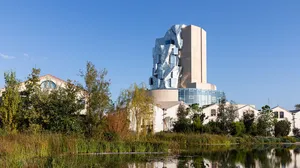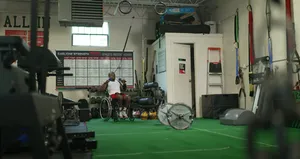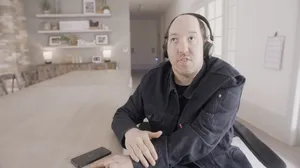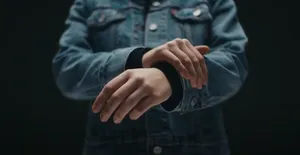The making of “Pearl”

Spotlight Stories' “Pearl” follows a father and daughter as they travel the country in their beloved hatchback, chasing their dreams. Created and produced as an interactive VR experience, a 360 video, and a theatrical short film, “Pearl” premiered last summer at the TriBeCa film festival, and is nominated this year for an Oscar for best animated short film.
With the Oscars just a few days away, we asked Director Patrick Osborne, Producer David Eisenmann, Music and Sound Creative Director Scot Stafford, and Technical Art Lead Cassidy Curtis to reflect on the journey of “Pearl.” You can watch “Pearl” on the YouTube app, on Daydream through the YouTube VR app, on the Google Spotlight Stories app for iOS and Android, or on HTC Vive.
Patrick Osborne, Director
My father is an artist and has worked as a toy designer. He loved to draw. He sacrificed a lot, as most parents do, in order to provide the best life for me and my brothers. One of those sacrifices was choosing family over career. “Pearl” was inspired by our relationship. Parents give us much more than material things—they give us taste, passion, their time. The time I spent drawing with my dad as a kid set up a foundation for the career I have today.

I think of “Pearl” as a folk-roadtrip-VR-musical. In 360 and VR, you’re creating a film without the constraint of borders, edges or a frame or control over timing. That means the story is happening all around you, and the audience is free to look anywhere at any time. As a director, giving that control to the audience was a scary prospect.
I had to figure out how to tell a story that spanned decades without the typical editing cuts you experience in a traditional film, which make it easy to understand that time has passed. In order to tell this story the way I had envisioned it, I had to truncate time and transport the audience from scene to scene. I made the car the focal point of the story, used the car’s windows to frame and compose shots, and put the audience in the passenger seat.
David Eisenmann, Producer
Pearl is a single story made for several mediums at once: as a 2D theatrical film, a 360º interactive story, and fully immersive VR. All of these versions were built from the same core of story, animation, sound and music, yet to make the best possible version for each medium, we had to make different choices along the way. For example, the rhythm of editing from shot to shot was much quicker in 2D than in VR, with almost twice as many cuts between scenes. Working with Evil Eye Pictures, we used each medium’s strengths to help the others: to create the 2D version, Patrick actually “shot” the scenes in 360, using the mobile phone as a camera. Editor Stevan Riley assembled the film from this footage, much as he would do with one of his documentaries.
The result is a rare opportunity to see how one filmmaker tells the same story in all these different mediums. While the VR version feels like being there in the passenger seat with the characters, the theatrical version is more like watching their home movies. Different forms of intimacy, but they all bring you closer to these characters’ lives.
Patrick Osborne, Director
As a fan of modern folk and Americana trends in music, I jumped at the chance to wrap the story in a song. "No Wrong Way Home" perfectly complements the visual style of the film, and the lyrics and imagery leave room for the audience to see and hear a little bit of themselves in our story.
Scot Stafford, Music and Sound Creative Director
Patrick wanted the story to evolve through music and for the song to be passed from father to daughter, along with the car. After an extensive search for songwriters, he chose Alexis Harte and JJ Wiesler for their sketch that contained the refrain, “there’s no wrong way home.” It matched perfectly with Patrick’s vision and his early sketches.

With the lyrics of the song in hand, we brought in Nicki Bluhm and Kelley Stoltz to perform it. To make it sound as authentic as possible, they recorded wherever the father and daughter sang or spoke in the video—in the car, on the sidewalk, in a park, and on the radio. The song carries the story but the sound design carries the experience, so it was important to get these details right. Through sound effects and foley (reproduction of everyday sounds that add realistic background noises to a film), we tried to make the audience feel like they were really inside the car with these characters.

Cassidy Curtis, Technical Art Lead
Patrick’s vision for “Pearl” was that every prop, environment, and change in lighting would play a role in the narrative. This “story everywhere you look” approach meant that we’d have to create a huge number of assets, so their design needed to be relatively simple. We also knew that simplicity would help us engage the audience: it’s easier to empathize with less detailed characters. Production designer Tuna Bora created paintings that established the film’s visual style: a kind of “polygon impressionism” made of simplified shapes, with rich, expressive color palettes to convey the changing moods and seasons.
A few of the thousands of tiny color palettes used in Pearl. Each of these represents the car in one scene.
Left: computer-generated shadows are often too complex. Right: hand-made shadow shapes are simpler and more appealing.
Rough edges, light blooms and film grain bring all the elements together.
My job was to equip our team of digital artists with the tools to animate in this style. To do it, we had to think like painters. In a typical film or game, artists build objects, texture them, and let the computer illuminate them with realistic lights, which indirectly produce a color image. For “Pearl,” we turned that process upside down: we worked directly on final colors, using custom palettes for each scene. Instead of digital lights, we hand-crafted appealing shadow shapes and soft gradations of color. We roughened the edges, added blooms of light, and a final dusting of film grain to tie these elements together.
“Pearl” is just five minutes and 39 seconds long, but it’s packed with 14 characters, 26 different scenes and 38 shots. And with multiple versions of the film, it took a tremendous amount of behind-the-scenes magic to bring “Pearl” to life. Watch it now from our Spotlight Stories channel on the YouTube app, on Daydream through the YouTube VR app, on the Google Spotlight Stories app for iOS and Android, or on HTC Vive.





